Foreign Insulators
by Marilyn Albers
Reprinted from "Crown Jewels of the Wire", June 1996, page 22
FROM MY MAIL BOX
Dear Marilyn,
I tried to take some pictures of the insulator in question the last time I
wrote you. This insulator came from Bill Heitkotter in Fresno, CA. I'm not sure
on the correct CD number but it is close in size to CD 655. I would appreciate
it if you can tell me the CD number for this insulator.
Embossing: (F-Skirt) L’ELECTRO VERRE (R-Skirt) 98
Approximate measurements: (Width) 3-3/8" (Height) 6-1/8"
Color: Champagne bottle green
If you have any other questions, please don't hesitate to ask.
Thank you,
LeRoy Niemi of Green Bay, Wisconsin
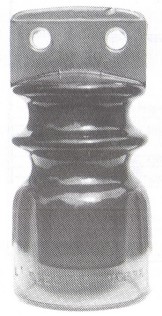
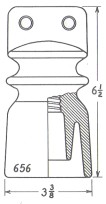
Dear LeRoy,
Your 'L’ELECTRO VERRE 98' is CD 656. I recently acquired one of these from
Pat Patocka of Penryn, California, same color and measurements as the one you
have. It's a couple whiskers shorter and narrower than the FOLEMBRAY insulator
to which this CD was originally assigned, but not enough difference to warrant a
new number.
This is a beautiful piece of glass and a new listing since "Glass
Insulators from Outside North America" was published. Your photos and
sketch of the insulator along with measurements really helped to identify the
piece. The upcoming price guide for G.I.F.O.N.A. will definitely include this
new embossing, so watch for it! Thanks for writing - any time.
Marilyn,
Hello, enjoy your articles in Crown Jewels. Looked at back issues and
couldn't find this one although I didn't have all back issues.
I'm not much of a drawer, but picked this porcelain insulator up in Portland,
Oregon. I think it's a foreign piece. Any information okay. Put it in Crown
Jewels if it's a different one. Would also send it to you if you'd like to see
it.
Yours,
James Dennis of The Dalles, Oregon:
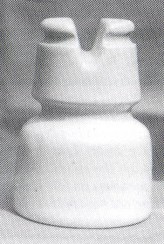

Dear James,
Your white porcelain insulator is definitely foreign and is shown as U-1801
in the 1986 Supplement to "Worldwide Porcelain Insulators". I have
enclosed a photo and scale drawing of the exact same insulator in my own
collection. Thanks for your sketches of the piece, including height measurement
and the incuse markings.
The marking IFÖ 56 on the unglazed top indicates that the insulator was made
in 1956 by a company called IFÖWERKEN or IFÖ Works, established in the 1920's
and presently located in Brömalla, Sweden. (IFÖ is a word in itself, but I
don't know what it means.) The company also operates an insulator factory in
Frauenthal, Austria. Both plants are technically advanced, and as part of a
larger group of European insulator manufacturers known as CERAM, they are
considered to be among the world's leading manufacturers of high voltage
insulators.
The U-1801 is not particularly scarce, but the shape is interesting. I would
value a mint specimen at about $10-$15. There is also a larger version, U-1809,
with a base diameter of 3-1/4" and a height of 4-7/8". You might have
to pay a few more $$$ for that one. The white glaze is common to both styles,
but the IFÖ catalog shows the U-1809 in a brown glaze as well. Hope this helps
you.
Dear Marilyn,
Hopefully, you may be able to answer my question on a Brazilian unipart
insulator. Last week I found an insulator along a utility right of way being
taken down for road improvements. The piece is underglazed in light blue as
follows:

It looks as though the closest U-number is U-660. The dimensions match,
however, the crown is slightly different. It is a standard light gray skytone
with black radio treatment both on top and in the pinhole.
I am very much in the dark on foreign porcelain, so this may be a common
name, but I would like some information. Hopefully it is a piece no one has ever
heard of, thus generating a new case to research. In any event, I thought I
would call it to your attention. And, since we are on the subject of foreign
porcelain, is there any book listing the U-numbers and M-numbers of these
pieces? Your foreign glass book is a very nice part of my insulator reference
library, and it seems fit to have one on porcelain also.
Thank you very much,
Patrick Scott of St. Louis, Missouri
- - - - - - - - - -
Dear Patrick,
The full name of the company that produced your insulator is Ceramica Santana
Sociadad Anonima, or Santana Insulators, Inc. With two manufacturing plants,
both located in Sao Paulo, Brazil, it is the largest producer of porcelain
insulators for electrical purposes in the Southern Hemisphere, and one of the
biggest in the world, producing more that ten thousand different types of
insulators for low, medium, high and extra-high voltage up to 800 kV. Santana's
Electro-Mechanical Laboratory is equipped to perform tests according to A.B.N.T.,
ANSI, I.E.C. DIN and other internationally known standards. Established in 1941,
the company has had 55 years of experience in production, development and
service and is completely dedicated to research and quality. The Santana sales
office is located in Miami, Florida. Their insulators are being used on power
lines right here in Texas, as well as in other parts of the U.S. and Canada.

Much of this information, including copies of several pages from Santana's
catalog, was sent to me by Mark Miner of Longmont, Colorado. After going through
all of them again, I think I have found your insulator! According to the
description you gave me, the style and dimensions on the enclosed drawing are a
match.
Enclosed are photos of two Santana insulators in my own collection. On the
small suspension type, 'Santana' appears in raised letters on the metal cap. You
see it again in underglazed black ink along with the date '84' on the top ring
of the porcelain body. The large pin type is a cemented two piece insulator with
black radio treatment both on the crown and in the pin hole. It's tiny but
perhaps you can make out 'Santana 88 - Brasil' underglazed in black ink on the
top shell of this piece. I have recently acquired a near dead ringer (not shown)
to this insulator except that it is made all in one piece and weighs
considerably less. A very interesting variation! The trademark is underglazed in
light blue ink on the bottom skirt and dated '1995 03', followed by the number
'5015'.
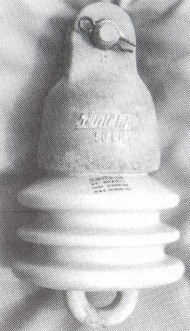
As for books on foreign porcelain insulators and whether or not these styles
will be assigned U-numbers or M-numbers, the Worldwide Porcelain Insulators
books already include foreign unipart insulators with U-numbers. My co-author
Jack Tod was always reluctant to include the foreign multiparts and felt that
they should be a separate group for someone else to tackle. Elton Gish and I
have had some discussion about these foreign multis and how to handle them, but
no decisions have been made at this time. If they should be classified with
style numbers, they will not be M-numbers but FM (Foreign Multipart) numbers. At
the top of the list right now is the task of combining the two Worldwide
Porcelain Insulators books into one updated volume. And it will be a fat one. I
have a huge box full of drawings waiting to be assigned U-numbers! Please write
again when you have questions.
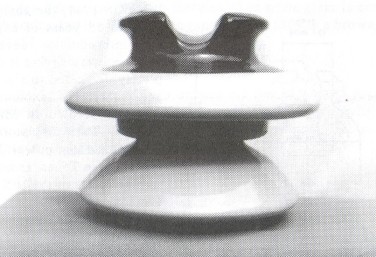
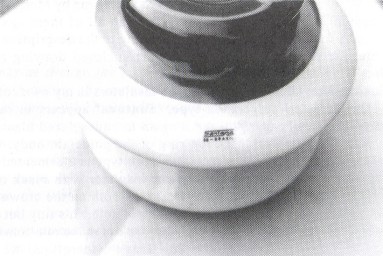
| 